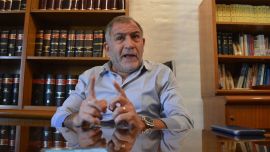Luis Ignacio Brusco is the dean of the Medical Faculty of the University of Buenos Aires (UBA) and president of the Argentine Neuropsychiatric Association. MD and PhD, psychiatrist, neurologist and researcher, in his latest book El cerebro político (“The Political Brain”) the 58-year-old lists, chapter by chapter, the cerebral functions which enter into decision-making, the different characteristics of both voters and leaders in an interplay between neuropolitics, philosophy and artificial intelligence, all while trying to explain where we are heading as a society.
Brusco is a CONICET researcher, professor and head of the Department of Psychiatry and Mental Health in the UBA Medical Faculty, where he directs his Centre of Cognitive Neurology and the Observatory of Bioethics. His main research has been into Alzheimer’s disease, studying its biological rhythms, and one of his major contributions to the world of neuropsychiatry has been the concept of “cognitive resilience.”
In your book, El cerebro político, you speak of neuropolitics and political psychology as a new subspecialty of neuroscience, forming part of an area which studies human conduct when making decisions. Why do you think that these new subspecialties are currently so preponderant? The same thing is happening in social sciences, with Political Communication one of the courses growing most.
The advances of science have generated a revolution when it comes to studying decision-making – call it neuroeconomics, neuropolitics or neuro art, extending that prefix to many other things such as journalism, etc. So the advances in the study of brain functions via magnetic resonance imaging are zero aggressive and permit us to see when and how a person acts in given situations, both before and after. Also the advance of neuropsychology via cognitive tests with a points system permitting us to see many intellectual, linguistic, decision-making and pragmatic variables, etc.
But fundamentally, as a very well-known neurobiologist called Michael Gazzaniga said, we mammals are living beings and Homo sapiens is a mammal who makes his decisions in pursuit of survival. As we explain, decision-making can be short-term, medium-term or long-term with the latter thinking far into the future – for example, what I study or whether to live in one country or another. Medium term is what I do next week, if I make a weekend trip, and very short-term is what I do in the next 15 minutes, or a turn of the wheel when driving in the face of some contingency. The interesting thing here is to see that the emotional, instinctive and subconscious information intervenes very strongly, obviously in the short term, which is an instance of rapid action like saving a penalty. The medium-term is much more cognitive and rational, for example, there is an announcement of rain and one makes the decision to take a raincoat or umbrella. And the interesting thing is that long-term conduct is pretty similar to the very short term, strongly assertive. The conclusion that long-term decision-making can lead to success is much more instinctive and much more importance must be given to the heart, metaphorically speaking, with the intuition that it will be rationally produced. Rationalising too much only confuses.
You affirm in your book: “Electoral decision-making is emotional with different political scientists arguing that we decide emotionally, not rationally.” Is today’s society more emotional than before or was it simply undiscovered in the past when reason was still believed to be more important in electoral decisions?
Rash to say so but I believe that all populations have always worked very much with their emotions and instincts when taking the hasty electoral decisions made in other epochs of the history of humanity. In civil wars, etc. emotions were generally preponderant. Indeed today it is known that memory, which is also novel, is much more important for intellectual or cognitive functions than supposed. When we look at artificial intelligence or simply buy a computer, the most expensive computer is the one with the most memory. The value of this memory function is clearly very important but what is recovered from the memory is very little. Generally everything we recall we also lose or store in our conscious. That does not mean that cerebral questions are not modified but that sometimes we cannot even bring that information to mind, bringing the past into the present but modified. Sometimes and sometimes not but in general it is much more we forget than we remember. That is why the definition of memory is more a function of what we forget than what we recall. So clearly memory, influencing our daily functions, is only the tip of the iceberg for what is going on below the memory, interfering with everything “different.” Many years ago we defined the “different” as the four “C”s: eating, fighting, running and copulating [all words beginning with “C” in Spanish] - i.e. sexuality, aggression, fear and food. Today we have an impressive quantity of things ‘different’ like cooperation, altruism, egoism, vengeance, the tribal sense and placing oneself in space and time. And there are entire groups which dedicate themselves solely to studying this in animals, for example. All those instincts clearly have their impact on our memory, which is what brings our information into the present and makes us take a decision. How can it be said then that emotion and the subconscious do not have a strong impact on this question?
When taking that political decision, does that emotional side go being modified by reason with firstly the emotions being activated in accordance with the empathy which the candidate might generate and the belief system and then perhaps being modified by the more rational messages being emitted by that candidate?
Of course. The messages being emitted by the candidate, the advisory groups of the candidate or the media speaking about the candidate clearly go towards modifying our emotional systems and making us more rational. They go modifying our belief systems but what happens is that the confirmation of bias is very much in fashion. In other words, what is called liberal democracy is full of traps, as Yuval Harari points out clearly, and I agree in questioning the manipulation of the information we receive, the impact of artificial intelligence and the algorithms which also influence our own tribe. So when we pick up our mobile telephones, we believe that everybody has the same opinion as we do when in reality it is an absolutely algoríthmic trap working on confirming our bias. Now if a neutral journalist or person tries to reason with us and convince us rationally, the other person’s decision-making could very probably be modified but not by force. A person with very deeply rooted belief systems will be very difficult to convince. This mechanism strongly influences the undecided, those whose opinions are far less based on belief and more on the rational. It goes further, one good piece of advice is: “Don’t try to convince anybody who thinks differently because you’ll only reinforce their contrary beliefs.”
What does it have to do with, for example, the case of [libertarian Javier] Milei that when you wrote your book, you perhaps did not imagine the importance it was going to have nor that the more it was criticised, the more it was picked up?
Absolutely. It is based on the reinforcement of belief systems whereby any instance towards modifying that system cuts the other way, not because a rational process of convincing reinforces what is wrong but because other variants are sought.
For example, trying to empathise with the good which that candidate has to offer when trying to co-opt voters but without being aggressive.
For example.
The error made when dealing with both [Donald] Trump and [Jair] Bolsonaro.
Or is actually happening now with Trump, who is rising again [in the polls] because they are trying to fight him with the same weapons for which they always criticised him.
There are voters who have decided with quite a bit of anticipation for whom they are going to vote according to a belief system, while other voters decide on the spur of the moment, even inside the polling-booth. What is the difference between one and the other, what different brain mechanisms click in one type of voter and the other?
It is complex giving a mechanism, generalising is wrong, but we can talk about what happens with the undecided voters who decide in the queue or in the polling-booth and how much impact it has on the election that day. The question we are always asking ourselves – and I’m not a specialist in electoral politics, my specialty is Alzheimer’s and studying cognitive processes. I always say that the political brain is not the brain of politicians but the brain of the Homo sapiens of the polis. So many things can enter into the polling-booth, a family feud, an unshared Christmas decision, etc. But in the case of the election, an increasingly strong point today, it has a lot to do with the electoral curfew so that many of those interviews with candidates who rattle on for half an hour make for an absolutely non-subliminal campaign clearly modifying the voting parameter. Or conversely, candidates who speak out to run down their own people, we’ve also observed that – they go over the top, shall we say. For example, there might be somebody in the run-off unconnected to that kind of decision because they are not on the lookout for their own kind but for swing voters. If speaking out makes them lose precisely those swing voters, whether subconsciously or consciously, there can be an immediate reaction causing the loss of many votes.
Do different parts of the brain function in decision-making between those with very firm beliefs who decide beforehand and those who end up deciding their vote on the spur of the moment?
We could, in general, affirm that people with fixed beliefs have firmer ideas. Those ideas go varying from normal to fundamentalist. A fundamentalist will be impossible to change. Fixed ideas predate fundamentalism, which is a forced idea within the system of beliefs very difficult to modify. An obsessive idea is a degree below, like a dimmer, lowering the intensity of ideas. Doubts can even arise there because the obsessive are also full of doubts as an obsessive trait of their personality. They think a lot and it is at that instance when doubts can enter, which will very probably leave them doubting until the last moment. They are more open to modification because they also have processes of fear and I think that within those groups the processes of fear may perhaps be more important than the processes of conviction because phobias and obsessions go hand in hand. For example, fear of a crisis or a much worse social situation than what we are now undergoing, which personally I don’t think is so serious – as many people say – because we have social peace, which is important, and we respect that. Although there are obviously many difficulties, as we all know full well, it seems to me that people perceive, whether subconsciously or consciously, that social peace could be lost, which would be very complex.
In your book you say that people of conservative thinking have a more developed amygdala, responding to fear and the invasion of corporal space while progressives have a more developed prefrontal cortex, the cingulate gyrus, which regulates the motivation and resolution of conflicts. So could one, via a cerebral map, discover whether somebody is conservative or progressive?
In a certain way, yes. Not only in their political life but life in general, how they dress, their habits, how they always lean the same way. Conservatives are obviously going to be much more emotional, of course. The amygdala – which is Greek for ‘almond’ because it looks like one and anatomists are very imaginative people – is a subcortical nuclear structure and the zone containing the emotional memory. This structure’s function clearly works on the basis of emotion and the fearful conservative vote is thus plainly the vote of the amygdala from the functional viewpoint. And that structure is permanently working on people with both positive and negative effects. And there is a very interesting study from about 15 years ago by a scientist called [Joseph] LeDoux where he observed that the amygdala can be spotted from one face to the other ahead of cognition. And that’s incredible because anybody to whom this did not happen would surely not survive because they could not defend themselves beforehand. That has to do with such questions as gut feelings, contact, interaction, empathy, that sort of thing. When that person functions in terms of those gut feelings, they are clearly much more distrustful and being distrustful makes us conservative. This has also been studied in another area of neurocosas, neuromarketing. We sometimes don’t want to talk so much about neurocosas because we believe many questions to be more anthropological and psychosocial if only because that is the area of study where one works but I believe the intervention to be transversal.
You quote a study showing that magnetic resonance imaging functionally permits us to look at repulsive images or faces which produce clear differences between voters on the left and right. Is there a physiology of the grieta chasm?
We might say that there is a physiology of the grieta chasm but the question is whether the grieta is between the left and right or whether the left and right actually exist. I’m going off track but I think it is more confusing, I believe that there are also other questions, religious or tribal, we might say.
Which could be conservative or progressive …
Of course.
That duality between those who use the amygdala more and those who use the cingulate gyrus more.
Exactly.
How do you define that polarity?
Not between conservative and progressive nor between left and right. Voters on one side of the grieta or other in Argentina seem to me more like Boca Juniors versus River Plate than an ideological question at this point in time.
So what you are saying is that in the final analysis in Argentina there are as many people using the cingulate gyrus as the amygdala on the one side as on the other?
Exactly. There is currently so much confusion that I believe that must be what is happening, why there are so many doubts.
Does our grieta transgress physiology?
We have been so creative from the neurophysiological standpoint that we have transgressed the grieta. The prefrontal is the last area to be created in the evolution of Homo sapiens, and also in ontogenesis, the development of the individual, and ends up being minimised at the age of 30, that is the abstract, what might be understood as the “how comes?”
Ethics too.
Ethics and morality.
You also say in your book that the visual is the key to human communication so that a candidate’s gaze aims at our instinctive cerebral system and that we humans are visual beings, macro-optic, while the rest of mammals go more by smell, macrosmatic, so that if any candidate has a repulsive physiognomy, they will lose.
Physiognomy is indeed very important because we are, as it said in the book, retinal or macro-optic, which means highly optical, but that has its repercussions in the nervous system. The visual area of our brain is very large when compared with other animals, including chimpanzees. In fact the human brain grows forward like a rugby ball, making us very prefrontal and intellectual while macro-optic behind, for which looking is very important. That can be seen in Alzheimer’s disease. What we advise the caregivers of this disease is that they never stop looking because apart from the patients having difficulties with their memory, they feel the loss of personality and have every type of difficulties, so if they do not have visual contact, they lose tons more information and the person feels much more depersonalised. Activities are so much better in visual form, love, interpersonal relationships, just looking. That famous expression, “this person does not seem very trustworthy to me because he does not look me in the eye,” is because you can size somebody up looking them in the eye - it has to do with that.
You mentioned that the frontal lobe was not only the last to evolve in mammals, reaching human beings, but also that it develops over time, being complete at the age of 30. Could this make young people vote differently?
Absolutely. The prefrontal lobe completes its myelination at the age of 30. There are two major health problems in adolescence, which incredibly begin earlier and end later. They start earlier because children [today] are much more stimulated, almost at the start of their teens, and are prolonged until 30 because they stay beyond their adolescence with their families whose lives are also longer while adolescence in itself is not a stage observed in any other animal so that the youth has to make different decisions. And the two great problems in youth are road accidents and suicide, which is the second cause of mortality and which we always try to communicate very subtly because the prevention campaigns for these issues are very problematic. But this has to do specifically with impulses, a limbic development of the amygdala which we have said to be doubting, emotional, impulsive, without a prefrontal development to inhibit those functions. That is why this is not what nature or biology intends because we Homo sapiens have the need to leave our families and seek new alternatives. We are born very gregarious with a prefrontal lobe, Homo sapiens is very gregarious, building cities and forming tribes but that quest which makes us progress also carries certain consequences, the accidents and the problem of suicide because there is no control over that emotion. They love harder and drive faster.
So there is a certain degree of logical correlation between young voters electing more impulsive candidates and older voters electing more moderate or conservative candidates?
That’s right. There are neurons called mirror or reflex neurons which click when somebody else is doing something which we are not - that other person moves an arm and our neurons, which are planners of movement, moves our arm. With emotions much the same thing happens with you reflecting another person and vice versa. As from today I’m looking at an image of [Sigmund] Freud from behind a camera but we neuroscientists are clearly not against Freud and many things he said are really so, such as transfer and countertransference. There is clearly both countertransference and transfer between Milei and youth, amplified by the trap of artificial intelligence. The mobile telephone is clearly generating algorithms and tribes, which is revolutionising this communicational space, leaving the historic candidates, with their historic methodologies, offside.
Production: Melody Acosta Rizza and Sol Bacigalupo.




















Comments